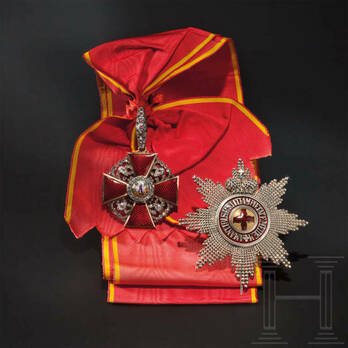Order of St. Anne, Type II, Civil Division, I Class Set of Insignia in Diamonds
CATEGORY: Version
SKU: 01.RUS.0113.100.01.100
Estimated market value:

Estimated market value:
Sash decoration fashioned in outstanding goldsmith technique, the convex cross arms finely engraved on gold background of intense vibrancy and covered with translucent red enamel executed in minute detail. The medallion ring, the arabesques between the cross arms and the anterior suspension ring in silver (partly gilt) studded with diamonds, the suspension ring in gold with jeweller’s engraving can be opened and is attached to the original sash of silk moiré. Width 53.2 mm.
The larger gemstones replaced by simili and, as was usual for decorations with brilliants, without official hallmark, since it was paid from the tsar’s private funds.
Comes with the corresponding Breast Star in facetted (!) version for the field or dress uniform fashioned in finest silversmith technique (with copious piercing) on a long pin. The medallion partly in gold, finely engraved and enamelled in translucent red. Above the medallion the facetted crown appliqué screw-mounted on the back, the reverse covered with gold-plating. The screw-mounted cover plate with mark of fineness for "84" zolotniki (.875 pure silver), the St. Petersburg hallmark and the maker’s initials "HF", presumably for Heinrich Freyburg (master between 1844 and circa 1860). One ball on the left tip of the star missing. Magnificently crafted, impressive breast star. Height 92.2 mm.Weight 52 g.
The Order of St. Anne was founded in memory of Schleswig-Holstein's wife Anna Petrovna (daughter of Peter the Great). Emperor Paul I established the Order as purely Russian. It was initially awarded for distinguished civil merit, and was expanded as a military award for war service after 1855.
The award was conferred by Duke Frederick of Schleswig-Holstein in memory of his wife Anna Petrovna, and was not considered a Russian award. The Type I Order was awarded only one Colonel, the Col. E.I. Vlastov.
The insignia of St. Anne on the badge and the cross on the star was changed to the Imperial Eagle when awarded to non-Christians.
The reverse features the first letters of the Order's motto, "AMANTIBUS, JUSTITIAM, PIETATEM, FIDEM."
The Order grades which have black enamel instead of red enamel on the arms, are early versions of this Order. They are referred to as "Black Annes" and were a popular version awarded in the late 1800s.
In 1815, Emperor Alexander I added a IV Class Badge to the Order, which was strictly awarded for military merit.
From 1796 to 1828, the I and II Class Badges have versions that are decorated with brilliants. After 1828, I and II Class Badges with brilliants were only awarded to
foreign dignitaries.
In 1828, a bow ribbon was added to the III Class Badge to award men for military acts of valour.
Crowns were added as a version design element to the I and II Classe awards from 1828 to 1874.
In 1844, the Order was made conferrable upon non-Christians. On these awards, the obverse image of St. Anne was replaced with an image of the Imperial Eagle.
The Military Division version of Class I and II were added in 1855, and feature the addition of intersecting swords.
Beginning in 1857, the swords intersecting the III Class military award were moved to surmount the medal.

Comments
Sign in to comment and reply.


Scroll Top